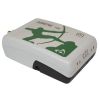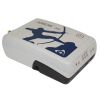Eos Arrow Gold GNSS Receivers
Features
- Supports GPS, GLONASS, Galileo & BeiDou
- 100% Android, iOS, Windows compatible
- 1cm RTK real-time accuracy
- Free ground shipping
- Expedited repair and warranty service
- Lifetime technical support
- More
The World’s Most Advanced GNSS Receiver for Every Mobile Device
The Eos Arrow Gold is a high-accuracy Bluetooth GNSS receiver that implements all four global GNSS constellations (GPS, GLONASS, Galileo, BeiDou), multi-frequency, and satellite-based RTK augmentation on iOS, Android, and Windows. Moreover, the new Arrow Gold+ adds full-band support for all GNSS signals, including Galileo’s free High-Accuracy Service (HAS). Both the Arrow Gold® and Arrow Gold+™ receivers support connection to popular apps like Esri’s ArcGIS apps and other mobile GIS apps on iOS, Android, and Windows.
RTK in Poor Cell Coverage Areas
SafeRTK is the answer. SafeRTK is a proprietary feature included exclusively with the Arrow Gold and Arrow Gold+ receivers. When cellular connection to the RTK network drops, SafeRTK takes over within a few seconds and maintains RTK-level accuracy for up to 20 minutes. This enables uninterrupted RTK accuracy in spotty areas.
No RTK Network?
The Arrow Gold supports low-cost global corrections. The Eos Arrow Gold features a 4cm, real-time satellite correction service called Atlas, available globally. Using all four constellations and signals, the Arrow Gold offers convergence times as low as 15 minutes at a revolutionary price point.
Multiplexing with the Arrow Gold+
The Arrow Gold+ has the functionality of the Eos Bridge Bluetooth connector built-in. Connect the Arrow Gold+ to any third-party sensor (e.g., laser rangefinder). The Arrow Gold+ will stream the content of that sensor to a chosen iOS or other mobile devices via the receiver’s own location datastream.
Ultimate Flexibility in Mobile Accuracy
iOS, Android, and Windows compatibility is our expertise. Eos Positioning Systems offers GNSS hardware with some of the most innovative, advanced connectivity on the market, supporting connection to popular apps like Esri’s ArcGIS and other mobile GIS apps.
- (1) Arrow Gold receiver with USB & Serial ports
- (1) Arrow Smart Battery Pack
- (1) L1/L2/L5 / LBand Precision Antenna
- (1) Large Antenna Mounting Plate
- (1) Two-section Short Antenna Cable for survey pole
- (1) Arrow Pole Mount Bracket
- (1) Range Pole Clamp
- (1) USB Data Cable
- (1) 12V International Power Supply for Arrow Smart Battery pack
- (1) Hard Shell Case
In The News
It’s Time to React to Water Quality: Proteus Multiparameter Probe aboard NexSens Buoy
Water quality monitoring is essential for safeguarding public health, protecting ecosystems, and ensuring the sustainability of water resources. Contaminants such as industrial pollutants, agricultural runoff, and sewage discharge can severely impact aquatic life and pose serious risks to human health if left unchecked. Traditionally, water quality monitoring has been a slow and labor-intensive process, requiring samples to be collected, transported to a lab, and analyzed—a process that can take days. However, with the advancement of real-time sensor technology, environmental agencies, researchers, and industries can now monitor water quality instantly.
Read MoreSafeguarding Communities with Real-Time Flood Monitoring in the City of Hazelwood
The City of Hazelwood is a suburb in St. Louis County, Missouri, home to around 25,500 people. Recently, the community has suffered increased flash flooding following severe storms, prompting the need for the installation of a flood monitoring system. In 2022, a NexSens X2 data logger was installed to monitor water level and rainfall in real-time, with the aim of reducing the loss of life and property as a result of extreme weather events. [caption id="attachment_39411" align="alignnone" width="940"] The latest flood event at Coldwater Creek, where the water level rose by 14 feet, exceeding the height of the X2 by three feet. The sensor can be seen behind the wall that usually contains the Creek.
Read MoreSave our Bogs! Culture, Conservation and Climate Action in Ireland’s Peatlands
Characterized by long-term accumulation under waterlogged conditions, peatlands exist on every continent and account for 3-4% of the global land surface . Small but mighty, these often overlooked wetland environments are estimated to hold as much as one-third of the world's organic carbon in their soil—twice the amount found in the entirety of the Earth's forest biomass. While healthy peatlands can trap and store carbon, regulate water, and provide important habitats for rare species, human alteration has disturbed peatland carbon and nitrogen cycles on a global scale. Approximately 12% of the world’s peatlands have been drained and degraded through conversion for agriculture, forestry, infrastructure development, and other uses.
Read More







































